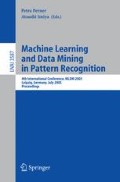Abstract
The feature selection allows to choose P features among M (P<M) and thus to reduce the representation space of data. This process is increasingly useful because of the databases size increase. Therefore we propose a method based on preferences aggregation. It is an hybrid method between filter and wrapper approaches.
Access this chapter
Tax calculation will be finalised at checkout
Purchases are for personal use only
Preview
Unable to display preview. Download preview PDF.
References
Almuallim, H., Dietterich, T.G.: Learning with many irrelevant features. In: Proceedings of the Ninth National Conference on Artificial Intelligence, pp. 547–552. AAAI Press, Menlo Park (1991)
Almuallim, H., Dietterich, T.G.: Efficient algorithms for identifying relevant features. In: Proc. of the 9th Canadian Conference on Artificial Intelligence, pp. 38–45. Vancouver, BC (1992)
Battiti, R.: Using mutual information for selecting features in supervised neural net learning. IEEE Trans. on Neural Networks 5, 537–550 (1994)
Blake, C.L., Merz, C.J.: UCI Repository of machine learning databases, Irvine, CA. University of California, Department of Information and Computer Science (1998), ftp://ftp.ics.uci.edu/pub/machine-learning-databases/
Blum, A.L., Langley, P.: Selection of relevant features and examples in machine learning. Artificial Intelligence, 245–271 (1997)
Breiman, L., Friedman, J.H., Olshen, R.A., Stone, C.J.: Classification and Regression trees. The Wadsworth Statistics/Probability Series. Wadsworth, Belmont (1984)
De Mantaras, R.L.: A distance-based attribute selection measure for decision tree induction. Machine Learning 6, 81–92 (1991)
Hall, M.: Correlation-based feature selection of discrete and numeric class machine learning. In: Proceedings of the International Conference on Machine Learning, pp. 359–366. Morgan Kaufmann Publishers, San Francisco (2000)
Hart, A.: Experience in the use of an inductive system in knowledge eng. In: Bramer, M. (ed.) Research and Development in Expert Systems. Cambridge Univ. Press, Cambridge (1984)
John, G.H., Kohavi, R., Pfleger, K.: Irrelevant Features and the Subset Selection Problem. In: Proc. of the 11th International Conference on Machine Learning ICML 1994, pp. 121–129 (1994)
Jun, B.H., Kim, C.S., Song, H.Y., Kim, J.: A New Criterion in Selection and Discretization of Attributes for the Generation of Decision Trees. IEEE Transactions on Pattern Analysis and Machine Intelligence (PAMI) 19(12), 1371–1375 (1997)
Kira, K., Rendell, L.A.: The feature selection problem: Traditional methods and a new algorithm. In: Tenth National Conference on Artificial Intelligence, pp. 129–134. MIT Press, Cambridge (1992)
Kira, K., Rendell, L.: A practical approach to feature selection. In: Proceedings of the Tenth International Conference on Machine Learning, Amherst, Massachusetts. Morgan Kaufmann, San Francisco (1992)
Kirkpatrick, S., Gelatt, C.D., Vecchi, M.P.: Optimization by simulated annealing. Science 220, 671–680 (1983)
Kononenko, I.: Estimating attributes: analysis and extensions of Relief. In: Bergadano, F., De Raedt, L. (eds.) ECML 1994. LNCS, vol. 784, pp. 171–182. Springer, Heidelberg (1994)
Lallich, S., Rakotomalala, R.: Fast feature selection using partial correlation for multivalued attributes. In: Zighed, D.A., Komorowski, J., Żytkow, J.M. (eds.) PKDD 2000. LNCS (LNAI), vol. 1910, pp. 221–231. Springer, Heidelberg (2000)
Langley, P., Sage, S.: Oblivious decision trees and abstract cases. In: Working Notes of the AAAI 1994 Workshop on Case-Based Reasoning (1994) (in press)
Liu, H., Setiono, R.: Chi2: Feature selection and discretization of numeric attributes. In: Proceedings of 7th IEEE Int’l. Conference on Tools with Artificial Intelligence (1995)
Liu, H., Setiono, R.: A probabilistic approach to feature selection-a filter solution. In: Proceedingof International Conference on Machine Learning, pp. 319–327 (1996)
Liu, H., Motoda, H., Dash, M.: A monotonic measure for optimal feature selection. In: Nédellec, C., Rouveirol, C. (eds.) ECML 1998. LNCS, vol. 1398, pp. 101–106. Springer, Heidelberg (1998)
Liu, H., Motoda, H.: Feature Selection for Knowledge Discovery and Data Mining. Kluwer Academic, Dordrecht (1998)
Marcotorchino, J.-F., Michaud, P.: Heuristic approach to the similarity aggregation problem. Methods of Operations Research 43, 395–404 (1981)
Marcotorchino, J.-F.: Agrégation de similarités en classification automatique, thèse de Doctorat d’Etat, Université Paris 6 (1981)
Michaud, P.: Agrégation à la majorité 1: Hommage à Condorcet, Rapport du Centre Scientifique IBM-France, N°F-051 (1982)
Mingers, J.: Expert systems — rule induction with statistical data. Journal of the Operational Research Society 38, 39–47 (1987)
Modrzejewski, M.: Feature Selection Using Rough Sets Theory. In: Brazdil, P.B. (ed.) ECML 1993. LNCS, vol. 667, pp. 213–226. Springer, Heidelberg (1993)
Narendra, P.M., Fukunaga, K.: A Branch and Bound algorithm for feature subset selection. IEEE Transactions Computers C-26, 917 (1977)
Nicoloyannis, N., Terrenoire, M., Tounissoux, D.: An optimisation model for aggregationg preferences: A simulated annealing approach. Health and System Science 2(1-2), 33–44 (1998)
Nicoloyannis, N., Terrenoire, M., Tounissoux, D.: Pertinence d’une classification. Revue Electronique sur l’Apprentissage par les Données 3(1), 39–49 (1999)
Quinlan, J.: Introduction of Decision Trees. Machine Learning 1, 81–106 (1986)
Shannon, C.E.: A mathematical theory of communication. Bell System Technical Journal 27, 379–423, 623–656 (1948)
Sheinvald, J., Dom, B., Niblack, W.: A modelling approach to feature selection. In: Proceedings of Tenth International Conference on Pattern Recognition, vol. 1, pp. 535–539 (1990)
Zhou, X., Dillon, T.S.: A Statistical–Heuristic Feature Selection Criterion for Decision Tree Induction. IEEE Transactions on Pattern Analysis and Machine Intelligence 13(8), 834–841 (1991)
Zighed, D.A., Rakotomalala, R., Rabaséda, S.: A discretization method of continous attributes in induction graphs. In: Proc. of the 13th European Meetings on Cybernetics and System Research, pp. 997–1002 (1996)
Erray, W.: WF: Une méthode de sélection de variables combinant une méthode filter rapide et une approche enveloppe. In: 11èmes Rencontres de la Société Francophone de Classification (SFC 2004), Bordeaux, Septembre (2004)
Author information
Authors and Affiliations
Editor information
Editors and Affiliations
Rights and permissions
Copyright information
© 2005 Springer-Verlag Berlin Heidelberg
About this paper
Cite this paper
Legrand, G., Nicoloyannis, N. (2005). Feature Selection Method Using Preferences Aggregation. In: Perner, P., Imiya, A. (eds) Machine Learning and Data Mining in Pattern Recognition. MLDM 2005. Lecture Notes in Computer Science(), vol 3587. Springer, Berlin, Heidelberg. https://doi.org/10.1007/11510888_21
Download citation
DOI: https://doi.org/10.1007/11510888_21
Publisher Name: Springer, Berlin, Heidelberg
Print ISBN: 978-3-540-26923-6
Online ISBN: 978-3-540-31891-0
eBook Packages: Computer ScienceComputer Science (R0)

